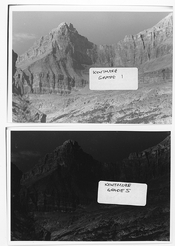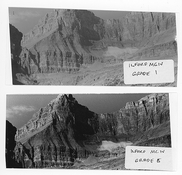I have had a problem with Kentmere VC Select Fine Lustre (7x5)
Equipment used
Meopta Magnifax 4 with multigrade head
Ilford multigrade developer
Fotospeed stop bath and fixer
Nikon 63mm enlarger lens
I have been doing some test prints to find the correct exposure time for the kentmere paper. After a few tests I got a decent grade 2 print at f11 and time of 20 seconds.
As the multgrade head has a neutral density filter built into the colour filters for the different grades there should be no (significant) difference in the exposure time when printing with harder grades. However when I tried printing the same image at grades 3 -5 all that happened was that the images did get a bit more contrasty but also got significantly darker as the grade increased. I made no changes to the aperture or exposure time. I even used an Ilford EM10 meter to check the exposure and it actually showed a slight reduction in image brightness as the grade increased (which should have priduce a lighter print!!).
I then used Ilford MGIV pearl to produce a grade 1 and grade 5 print with the same exposure settings. This did exactly what it should have done - significant increase in contrast with a very small change in the brightness of the print.
As a final check I went back to the Kentmere and did another grade 2 and 5 with the same settings and the original darkening of image occurred again.
The Kentmere paper was purchased Nov 2023 and the MGIV purchased in 2009 and kept in a freezer, so I would have expected problems with the MGIV rather than the Kentmere(!)
Has anyone else experienced this problem or similar?
An explanation would be gratefully received.
Thanks
Equipment used
Meopta Magnifax 4 with multigrade head
Ilford multigrade developer
Fotospeed stop bath and fixer
Nikon 63mm enlarger lens
I have been doing some test prints to find the correct exposure time for the kentmere paper. After a few tests I got a decent grade 2 print at f11 and time of 20 seconds.
As the multgrade head has a neutral density filter built into the colour filters for the different grades there should be no (significant) difference in the exposure time when printing with harder grades. However when I tried printing the same image at grades 3 -5 all that happened was that the images did get a bit more contrasty but also got significantly darker as the grade increased. I made no changes to the aperture or exposure time. I even used an Ilford EM10 meter to check the exposure and it actually showed a slight reduction in image brightness as the grade increased (which should have priduce a lighter print!!).
I then used Ilford MGIV pearl to produce a grade 1 and grade 5 print with the same exposure settings. This did exactly what it should have done - significant increase in contrast with a very small change in the brightness of the print.
As a final check I went back to the Kentmere and did another grade 2 and 5 with the same settings and the original darkening of image occurred again.
The Kentmere paper was purchased Nov 2023 and the MGIV purchased in 2009 and kept in a freezer, so I would have expected problems with the MGIV rather than the Kentmere(!)
Has anyone else experienced this problem or similar?
An explanation would be gratefully received.
Thanks




